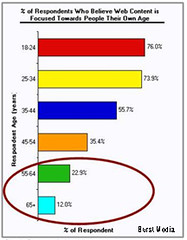• Only about half of respondents, ages 35-44, believe Web sites are designed for them.
• Only 36.9 percent of respondents, ages 45-54, believe Web sites are designed for them.
• Only 19.9 percent of respondents, ages 55+, believe Web sites are designed for them.
Ya think? Advertising has been trending younger for some time now, online and off. Online it’s evident, mostly because of the mistaken notion that Internet users are all young. Sometimes its because designers are designing in a bubble, with little thought to their audience. Sometimes its because advertisers are skewing too much toward the medium with little or no thought of people.
The reality is that everybody is online; More than 80 percent in the U.S.
One of the most recent polls conducted by Harris Interactive last Nov. estimated that 97 percent of Americans with a computer is online (hat tip: Gary Gerdemann Peritus Public Relations).
In fact, when you compare the online population with the total population in the United States, the columns are proportionate, with the exception to those ages 65+. In addition, Internet usage has increased from seven hours per week in 2002 to more than 11 hours today.
While prevailing social media theory tends to ask companies to bend their message for technology, the BurstMedia survey is a reminder that tools do not dictate messages. Brand relationships exist between the company and the consumer. Technology is only a means of delivery or engagement.
Currently, 12 percent of the population is the 65+ group. By 2050, this age group will comprise 21 percent of the population, according to the U.S. Census Bureau.
In addition, this demographic will be well versed in online technologies and usage, requiring designers to consider content organization and ease of use much more readily than they do today. It makes sense.
Given the amount of demographic and psychographic information advertisers and marketers are pulling from the net, one would think they would apply it online ads. Or maybe not. We hear the same complaints about broadcast advertising and programming too.



















6 comments:
Rich,
I do agree in general that many forms of media have skewed younger than they were a decade ago. In my broadcasting days, no one wanted 12-24 demos. Now you have a shotgun blast of media programming designed to hit that age category. Personally I think it goes beyond just skewing younger. I tell my real estate customers that marketing has become very narrow, designed to hit the hot button hard of a few prospects rather than a big target. There's a reason we have a Disney Channel, Weather Channel, ESPN and 24/7 cable news outlets. It's not about age, just specificity and loyalty of interest. In the natural evolution of marketing and media that would certainly support your concept of 'skewing younger' because before the mid 90's when the net really took off, I'm not sure most wanted to admit the young demos actually mattered.
Hey Greg,
Very observant. Niche marketing works, but sometimes it has a lower profit margin than the "all elusive general public mass market" audience has, which is what NBC Universal's Jeff Zucker was talking about today. However, sometimes what happens is that shooting for the broadest possible demo will backfire and you end up with a product no one wants.
The skew toward marketing younger seemed to start, as you said, in the 1990s. Part of the movement was tied to the "ahhh" factor, made possible by advances in PhotoShop and sexy special effects. It worked because the "ahhh" factor could crossed generation gaps. But, as "ahhh" became common, all we were left with were not-so-"ahhh" techniques and no message.
Example: Punching monkey ads. They were pretty novel for a day or two. And now they are annoying.
I've always valued real estate's approach because identifying the individual buyer just makes so much more sense. Sure, there are fast transaction agents, but the ones I know are niche specialists that somehow manage to retain the same clients during what can be a long as a 5-10 year sales cycle.
Personally, I value everyone. But realistically, I'm not completely convince the skewed young ads even work on the younger demos. At least, not in a way that will ensure a customer for years.
Best,
Rich
Hey Rich,
Today there was an article posted on cinemarealm.com entitled:
"Jericho, the Nielsen dinosaur and Gen Y campaigns"
The message of the piece is great but equating Jericho to a Generation Y campaign in the title is just plain silly. The community surrounding Jericho is diverse and multi generational and many of its members credit the show with challenging them to become more internet literate. In fact, I would have to say this age dynamic is one of my favorite things about the fandom.
-B
Demographics aside advertising is in need of a complete make over. The answer is not in interruption ads, ads before you can get to the content, ads on top of the content, and moving ads. We are considered targets, but we are moving too - elsewhere.
I've had a post brewing on this topic, although I know I've already written plenty on it.
Well, advertising campaigns have certainly overlooked me. I am sick to death of being ignored unless it's a commercial for adult diapers (we aren't all slobbering pant-wetting old fools)
@terocious You and I know too many Jericho fans to think that they consist of Gen Y campaigners. Ha.
@Valeria I would look forward to that post very much. I agree that we don't need to put a bullseye on an ad. Advertising works better sometimes when it's less intrusive.
@Granny. I think you're right. Many of the ads I see from time to time include products that appeal to 45+, but messages that might not. I suppose it works all right if you're chasing clicks as opposed to customers. There is a difference.
Post a Comment